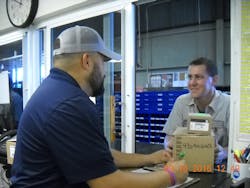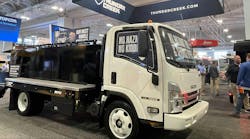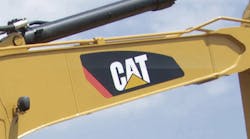Historians have known throughout the ages that conquering armies can be stopped in their tracks for lack of a dependable supply chain,” says Leigh Dennis, CEM, manager of fleet services, Carolina Sunrock. “Getting too far away from the supply sources stretches resources to the point where progress simply stops. Success of any campaign or business depends on the logistics of supply-chain management.”
The effect of a poorly managed supply chain, he says, “is devastating to morale.”
Reprinted with the permission of Equipment Manager magazine, the magazine of the Association of Equipment Management Professionals.
“Inventory management is not necessarily glorious, but it is absolutely essential to the success of an organization,” Dennis says. “It is, perhaps, the strongest link in the supply chain that maintains availability of parts and supplies that keep trucks moving and equipment working.
“When it comes to preventive maintenance, inspection, and condition inspection monitoring and repairs, parts management is always a work in progress, adapting to the evolution of technologies in markets that it both draws from and supplies.”
Balancing on-hand parts inventory levels with the levels of parts used less frequently is determined by a number of variables, he says. Chief among these variables is demand “D”: increased asset utilization demand. The ebb and flow of demand can also be affected by a number of factors that come from different customers and their individual needs.
“One customer may not have resources to maintain a parts inventory,” Dennis says. “Another customer may purchase parts in bulk to save on ordering and shipping costs by taking advantage of quantity price breaks. The fortunes of each customer will affect frequency of parts sales at different times.”
Normally, historical sales data will roll into reports that help determine inventory and level out the extremes. “The down side of this is that, in many cases, it is reactive in nature,” he says.
The downtime factor is another consideration. Parts management is all about getting the most value out of parts and supplies, he says. “Here, parts value is maximized through the use of proactive planning. A key element of operating efficiency is utilizing inventory as a tool to mitigate potential downtime and support operational efficiency,” Dennis says.
There are risks at times, he points out, since often you gamble on what you keep in stock for immediate needs versus what you ask your dealers to keep on the shelf for non-emergency use and restock.
That said, there are several ways to help alleviate wait time and reduce inventory costs. For instance, vendors can put mission-critical, higher-value parts on consignment at your location, says Dennis. “This guarantees parts availability for you and sales the vendor needs. This system works for anything from hydraulic pumps, steering gear boxes, and valves to mining tires and bucket cutting edges.”
Then there is the “pesky X-factor,” he says. These are consumable supplies and safety items. One way to help cut costs on these is to install automated, customized vending machines. “They are excellent tools that provide both parts and supply availability as well as the tools to apply cost-control items,” says Dennis.
The best way for parts to leave inventory is through an automated system that identifies the item and charges it out through the work order system.
Parts depreciation usually begins after the economic shelf life expires. “This is usually an internal setting that can be triggered by any number of variables, such as return-to-vendor deadlines, design obsolescence, and parts warranty expiration dates.
“If you operate at a higher level of fleet standardization of machines and procedures, then processes and parts planning becomes essential to operational efficiency. Therefore, when spec’ing a new machine, identifying service and wear parts commonality and identifying what you are or will be using, are top priorities.”
Steve Frazier, CEM, is director of equipment operations at AECOM, working worldwide in power industry, environmental, governmental and civil projects. Fleet size varies depending on the nature, length and location of the project.
“With the oil and gas business, we’ve probably eliminated 3,000 pieces of equipment,” Frazier says. “We do a lot of leasing and rentals. We do procure, depending on the length of the job, whatever makes sense financially. Our overall fleet number is very fluid because of the industry. Obviously, we like the warranty-type equipment leases and those types of things to lower our operating costs.”
Maximum levels of maintenance and service items are required on site at large jobs that are equipment intensive, according to Frazier. “Each project has different requirements, and each may be managed differently,” he says. “In some areas, we may rely on local vendors and suppliers and not maintain a parts inventory. In some cases, there are a lot of rental fleets with a multiple inventory of parts, but no consumable items. We try to manage those as consistently as possible.
“When we get ready to start a project, our vendors are a lifeline to equipment uptime and the project itself. We try to negotiate with the local dealer, who at least has OEM-recommended parts and parts lists. It is a win-win situation when we include them in the Equipment Triangle to assist us in having a profitable project.”
Single- and multiple-source vendors and suppliers have both advantages and disadvantages, according to Frazier. Developing a single-source relationship has an advantage in that it creates competitiveness and reduces overall operations cost. The disadvantage is the lack of competitiveness from internal area local supply sources, a source that is not close and readily accessible.
“The object is to maintain and operate our fleet,” he says, “and the requirement expected for our uptime, schedule, and productivity are critical.
A number of factors, including not having accessible parts and unforeseen maintenance that contribute to downtime, have to be carefully watched since they can increase the overall cost of a project, especially in a corporate-intensive fleet, Frazier says. Yet, there is always room for improvement in any aspect of equipment and fleet management. “You have to continue looking for items and procedures that can give us a competitive advantage on our overall maintenance cost and project success.”
Mike Brennan, CEM, manager of fleet services, and Angie Sharpe, materials manager, operate parts supply for Manatee County (Fla.) Fleet Services like a just-in-time supply operation.
“We do have stock and inventory of high-moving product, but our basic philosophy is when we know a machine is coming in we order the parts that are needed and get them in here,” Brennan says. “The team that Angie has is well-versed at doing this. Combined, they have more than 75 years experience, and over the last calendar year they have supplied 80 percent of the parts we need to service vehicles and machines for the various county divisions, such as public works, parks and recreation, property management, natural resources, and a host of other administrative departments including public safety and public transit vehicles in less than two hours.”
Sharpe says she inventories ordinary routine maintenance replacement items, such as filters, brakes, lights and tires, and has several local vendors for non-inventoried maintenance-type items. To put something into inventory, “we usually set a minimum three-turn in a 12-month period.”
“We’re talking about outsource parts,” Brennan says. “We stock inventory parts that we use on a regular basis. When we do preventive maintenance inspections or get reports that repairs are needed, we will order the item. When you have a repair generated from PM, those parts generally are ordered right then. We will not have them in stock.”
“To control in-house inventory levels, reports are run that show issues by calendar year. That’s what we go by,” Sharpe says. “If items in our inventory are not moving or the parts are obsolete, they are the first to go.”
Brennan explains the steps used in managing the shop department. “The equipment goes into the shop, and after it is determined what parts are needed for repairs, the technician many times goes online and pulls the schematics of the unit, gets the part numbers, and takes them to the parts window.”
The technicians are not restricted financially. If the part seems to cost an exceptional amount, the supervisor is called “to see if it’s needed and he’s good with it,” Brennan says.
Sometimes, however, a technician can under-order. For example, if he comes to the parts window with an order of five or six parts for a dump truck, but Sharpe’s team already knows what the job is, they will look at the order and say, “You may also need these additional parts, so they will call the supervisor over and suggest the additional parts be ordered at the same time.”
Sharpe says she has very good business relationships with many vendors through having worked with them for many years. “They know, for instance, we have a fleet of Chevrolets or John Deeres that may use the same type of parts,” she says. “If we ask them, they will stock the parts for us. If we have a project going on, they may pre-order repair items for us in order to have them on hand when the equipment comes in for repair. With heavy equipment, they will work with us to keep some parts on hand so we don’t have to put money into them.”
OEMs are good partners as well in parts management, says Brennan. “They know what’s going on and will call us if they spot an issue with an item. We also work with manufacturers of components, such as drivelines. We work with literally hundreds of vendors.”
Both Brennan and Sharpe strongly believe in using multiple sources for parts, he says.
“I don’t believe in single source. I don’t believe it works,” Brennan says. “An advantage of using several vendors: You can buy any one of them. We don’t have a lot of spare assets, so if we need something, we need it now and we just can’t wait. If I relied on a single vendor, I would be putting all my eggs in one basket, and I don’t believe that works.”
When Brennan has to buy parts for highly specialized equipment, however, he generally uses the OEM as a single source. For instance, his pothole patchers come only from a single-source OEM in Kansas. “But they know that, and they will ship second-day-air at a reasonable price so we don’t have to stock a lot of occassional used parts for them.”
One thing Brennan and Sharpe keep in mind: There is a cost to inventory, and you have to manage that inventory to make sure there is no waste on the shelf. Since Manatee County is a government operation, it often has to contact several sources for bids and get the best price it can.
“We generally will not issue a purchase order to a single vendor, so if Vendor A is currently out of stock, we automatically go to Vendor B. We will not let a single vendor bottleneck our operations.”
As Leigh Dennis, CEM, at Carolina Sunrock says, effective parts management may not be glorious, but it is necessary for survival, whether it’s an army or an equipment fleet.





